Leadership and Management Analysis: Imperial Hotel Case Study
VerifiedAdded on 2021/02/21
|16
|2822
|30
Case Study
AI Summary
This case study examines the management challenges faced by the Imperial Hotel in London, focusing on issues such as poor work culture, high employee turnover, and inadequate leadership strategies. The analysis identifies problems like a lack of employee monitoring, insufficient communication, and ineffective use of IT systems. The study then explores relevant management theories, including the Hackman and Walton leadership model and John Adair's action-centered leadership model, proposing solutions such as improved training and supervision programs, the implementation of Blake and Mouton's managerial grid, and a shift towards Burns' transformational leadership. These solutions aim to enhance employee engagement, improve service quality, and foster a more positive and productive work environment. The conclusion emphasizes the importance of a qualitative work environment, effective communication, and the integration of technology to achieve organizational success and customer satisfaction.
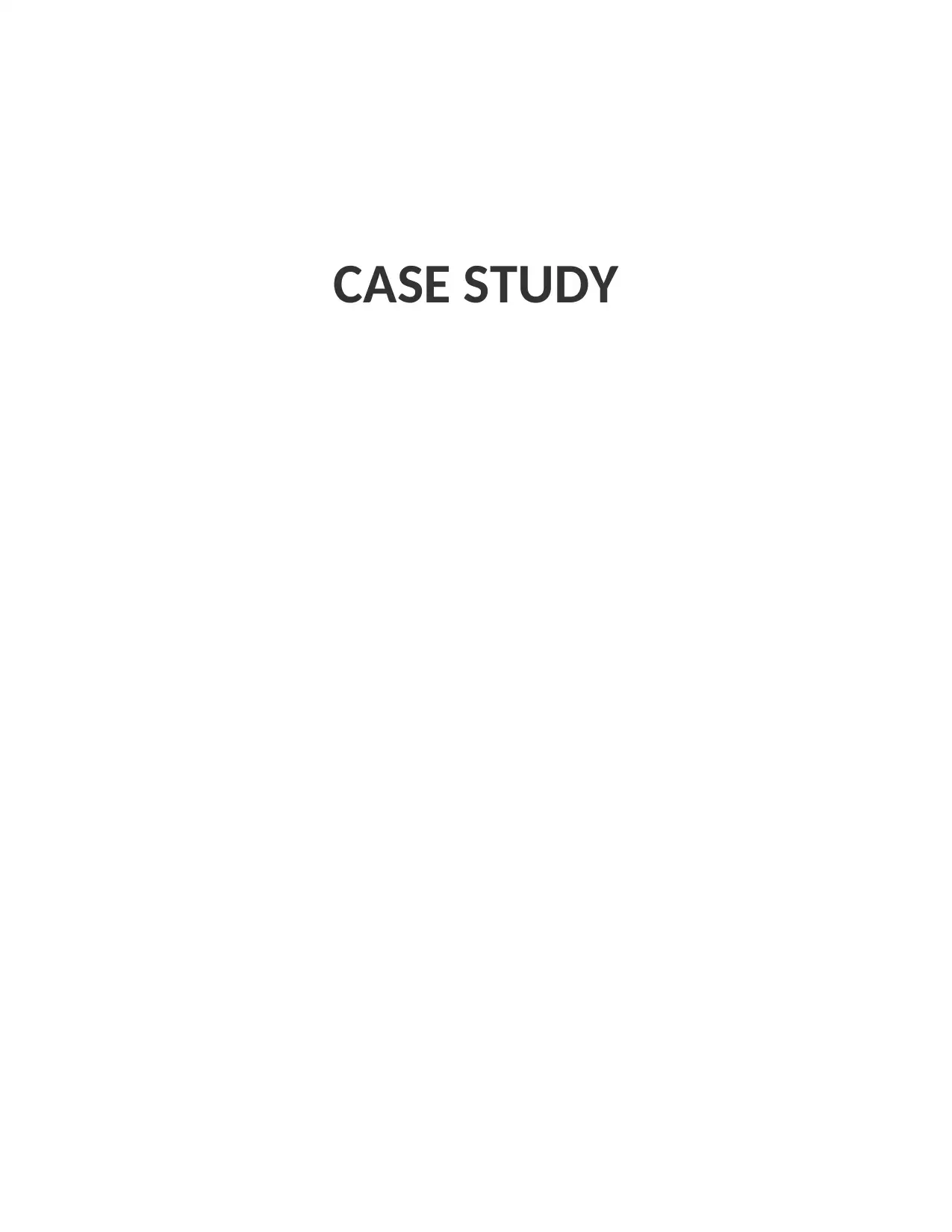
CASE STUDY
Paraphrase This Document
Need a fresh take? Get an instant paraphrase of this document with our AI Paraphraser

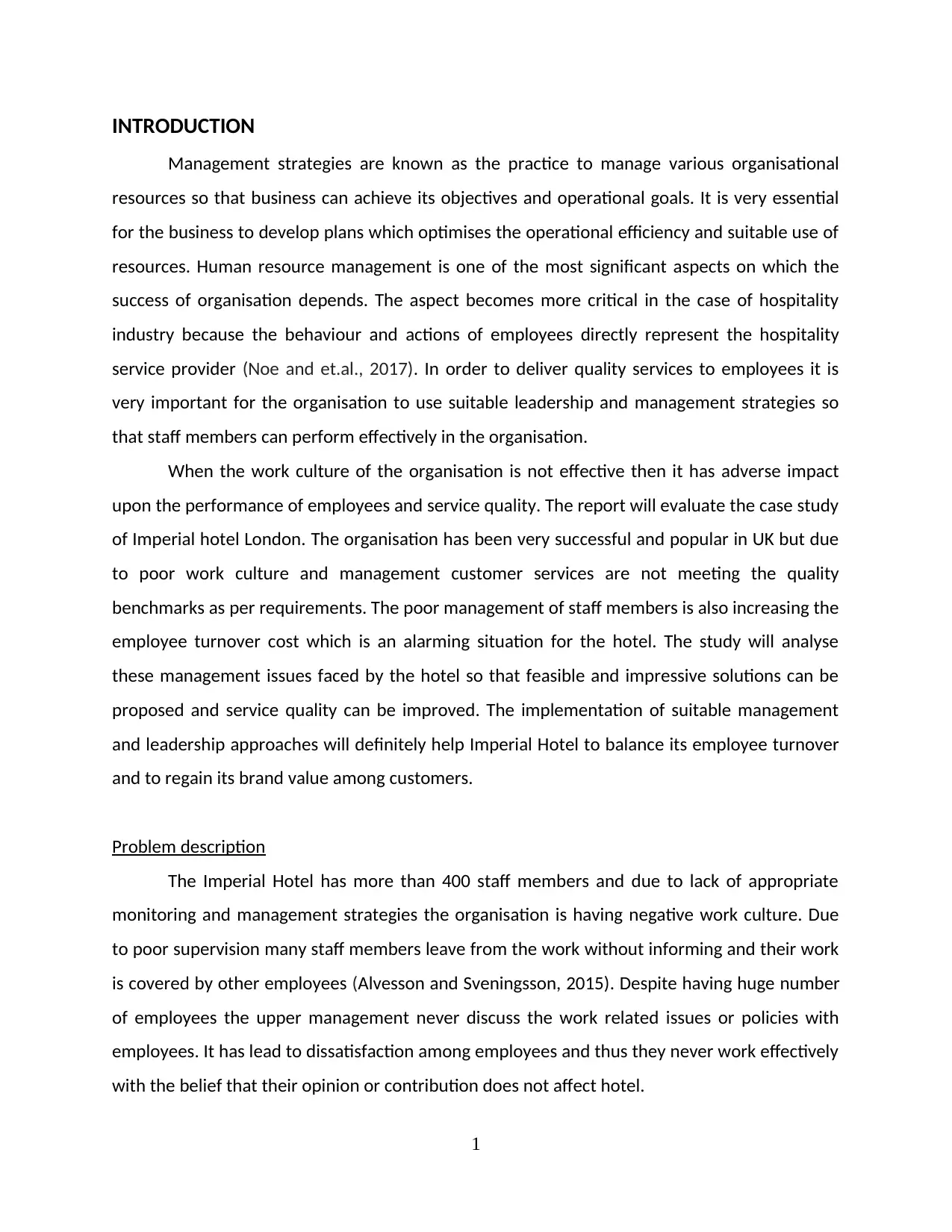
INTRODUCTION
Management strategies are known as the practice to manage various organisational
resources so that business can achieve its objectives and operational goals. It is very essential
for the business to develop plans which optimises the operational efficiency and suitable use of
resources. Human resource management is one of the most significant aspects on which the
success of organisation depends. The aspect becomes more critical in the case of hospitality
industry because the behaviour and actions of employees directly represent the hospitality
service provider (Noe and et.al., 2017). In order to deliver quality services to employees it is
very important for the organisation to use suitable leadership and management strategies so
that staff members can perform effectively in the organisation.
When the work culture of the organisation is not effective then it has adverse impact
upon the performance of employees and service quality. The report will evaluate the case study
of Imperial hotel London. The organisation has been very successful and popular in UK but due
to poor work culture and management customer services are not meeting the quality
benchmarks as per requirements. The poor management of staff members is also increasing the
employee turnover cost which is an alarming situation for the hotel. The study will analyse
these management issues faced by the hotel so that feasible and impressive solutions can be
proposed and service quality can be improved. The implementation of suitable management
and leadership approaches will definitely help Imperial Hotel to balance its employee turnover
and to regain its brand value among customers.
Problem description
The Imperial Hotel has more than 400 staff members and due to lack of appropriate
monitoring and management strategies the organisation is having negative work culture. Due
to poor supervision many staff members leave from the work without informing and their work
is covered by other employees (Alvesson and Sveningsson, 2015). Despite having huge number
of employees the upper management never discuss the work related issues or policies with
employees. It has lead to dissatisfaction among employees and thus they never work effectively
with the belief that their opinion or contribution does not affect hotel.
1
Management strategies are known as the practice to manage various organisational
resources so that business can achieve its objectives and operational goals. It is very essential
for the business to develop plans which optimises the operational efficiency and suitable use of
resources. Human resource management is one of the most significant aspects on which the
success of organisation depends. The aspect becomes more critical in the case of hospitality
industry because the behaviour and actions of employees directly represent the hospitality
service provider (Noe and et.al., 2017). In order to deliver quality services to employees it is
very important for the organisation to use suitable leadership and management strategies so
that staff members can perform effectively in the organisation.
When the work culture of the organisation is not effective then it has adverse impact
upon the performance of employees and service quality. The report will evaluate the case study
of Imperial hotel London. The organisation has been very successful and popular in UK but due
to poor work culture and management customer services are not meeting the quality
benchmarks as per requirements. The poor management of staff members is also increasing the
employee turnover cost which is an alarming situation for the hotel. The study will analyse
these management issues faced by the hotel so that feasible and impressive solutions can be
proposed and service quality can be improved. The implementation of suitable management
and leadership approaches will definitely help Imperial Hotel to balance its employee turnover
and to regain its brand value among customers.
Problem description
The Imperial Hotel has more than 400 staff members and due to lack of appropriate
monitoring and management strategies the organisation is having negative work culture. Due
to poor supervision many staff members leave from the work without informing and their work
is covered by other employees (Alvesson and Sveningsson, 2015). Despite having huge number
of employees the upper management never discuss the work related issues or policies with
employees. It has lead to dissatisfaction among employees and thus they never work effectively
with the belief that their opinion or contribution does not affect hotel.
1
⊘ This is a preview!⊘
Do you want full access?
Subscribe today to unlock all pages.

Trusted by 1+ million students worldwide
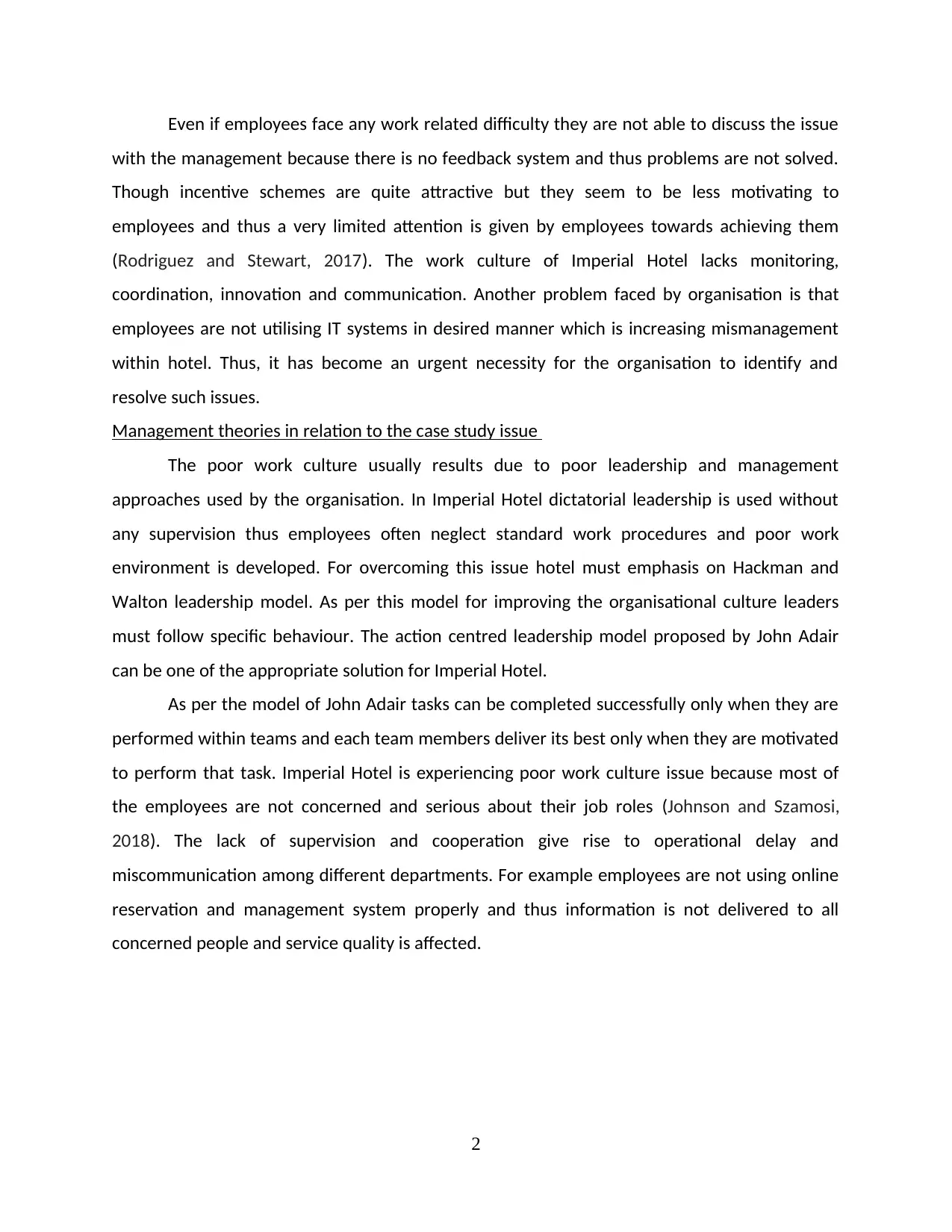
Even if employees face any work related difficulty they are not able to discuss the issue
with the management because there is no feedback system and thus problems are not solved.
Though incentive schemes are quite attractive but they seem to be less motivating to
employees and thus a very limited attention is given by employees towards achieving them
(Rodriguez and Stewart, 2017). The work culture of Imperial Hotel lacks monitoring,
coordination, innovation and communication. Another problem faced by organisation is that
employees are not utilising IT systems in desired manner which is increasing mismanagement
within hotel. Thus, it has become an urgent necessity for the organisation to identify and
resolve such issues.
Management theories in relation to the case study issue
The poor work culture usually results due to poor leadership and management
approaches used by the organisation. In Imperial Hotel dictatorial leadership is used without
any supervision thus employees often neglect standard work procedures and poor work
environment is developed. For overcoming this issue hotel must emphasis on Hackman and
Walton leadership model. As per this model for improving the organisational culture leaders
must follow specific behaviour. The action centred leadership model proposed by John Adair
can be one of the appropriate solution for Imperial Hotel.
As per the model of John Adair tasks can be completed successfully only when they are
performed within teams and each team members deliver its best only when they are motivated
to perform that task. Imperial Hotel is experiencing poor work culture issue because most of
the employees are not concerned and serious about their job roles (Johnson and Szamosi,
2018). The lack of supervision and cooperation give rise to operational delay and
miscommunication among different departments. For example employees are not using online
reservation and management system properly and thus information is not delivered to all
concerned people and service quality is affected.
2
with the management because there is no feedback system and thus problems are not solved.
Though incentive schemes are quite attractive but they seem to be less motivating to
employees and thus a very limited attention is given by employees towards achieving them
(Rodriguez and Stewart, 2017). The work culture of Imperial Hotel lacks monitoring,
coordination, innovation and communication. Another problem faced by organisation is that
employees are not utilising IT systems in desired manner which is increasing mismanagement
within hotel. Thus, it has become an urgent necessity for the organisation to identify and
resolve such issues.
Management theories in relation to the case study issue
The poor work culture usually results due to poor leadership and management
approaches used by the organisation. In Imperial Hotel dictatorial leadership is used without
any supervision thus employees often neglect standard work procedures and poor work
environment is developed. For overcoming this issue hotel must emphasis on Hackman and
Walton leadership model. As per this model for improving the organisational culture leaders
must follow specific behaviour. The action centred leadership model proposed by John Adair
can be one of the appropriate solution for Imperial Hotel.
As per the model of John Adair tasks can be completed successfully only when they are
performed within teams and each team members deliver its best only when they are motivated
to perform that task. Imperial Hotel is experiencing poor work culture issue because most of
the employees are not concerned and serious about their job roles (Johnson and Szamosi,
2018). The lack of supervision and cooperation give rise to operational delay and
miscommunication among different departments. For example employees are not using online
reservation and management system properly and thus information is not delivered to all
concerned people and service quality is affected.
2
Paraphrase This Document
Need a fresh take? Get an instant paraphrase of this document with our AI Paraphraser
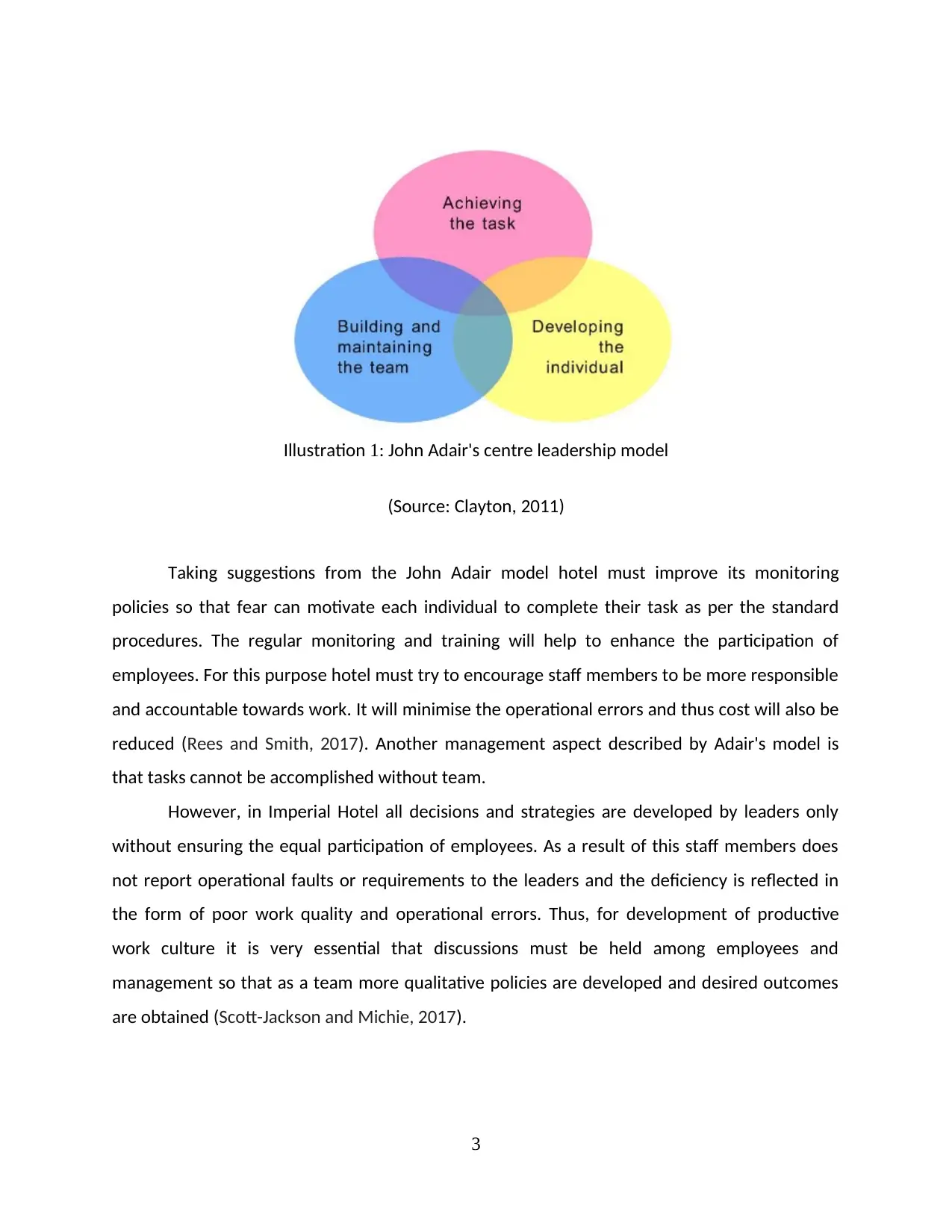
(Source: Clayton, 2011)
Taking suggestions from the John Adair model hotel must improve its monitoring
policies so that fear can motivate each individual to complete their task as per the standard
procedures. The regular monitoring and training will help to enhance the participation of
employees. For this purpose hotel must try to encourage staff members to be more responsible
and accountable towards work. It will minimise the operational errors and thus cost will also be
reduced (Rees and Smith, 2017). Another management aspect described by Adair's model is
that tasks cannot be accomplished without team.
However, in Imperial Hotel all decisions and strategies are developed by leaders only
without ensuring the equal participation of employees. As a result of this staff members does
not report operational faults or requirements to the leaders and the deficiency is reflected in
the form of poor work quality and operational errors. Thus, for development of productive
work culture it is very essential that discussions must be held among employees and
management so that as a team more qualitative policies are developed and desired outcomes
are obtained (Scott-Jackson and Michie, 2017).
3
Illustration 1: John Adair's centre leadership model
Taking suggestions from the John Adair model hotel must improve its monitoring
policies so that fear can motivate each individual to complete their task as per the standard
procedures. The regular monitoring and training will help to enhance the participation of
employees. For this purpose hotel must try to encourage staff members to be more responsible
and accountable towards work. It will minimise the operational errors and thus cost will also be
reduced (Rees and Smith, 2017). Another management aspect described by Adair's model is
that tasks cannot be accomplished without team.
However, in Imperial Hotel all decisions and strategies are developed by leaders only
without ensuring the equal participation of employees. As a result of this staff members does
not report operational faults or requirements to the leaders and the deficiency is reflected in
the form of poor work quality and operational errors. Thus, for development of productive
work culture it is very essential that discussions must be held among employees and
management so that as a team more qualitative policies are developed and desired outcomes
are obtained (Scott-Jackson and Michie, 2017).
3
Illustration 1: John Adair's centre leadership model
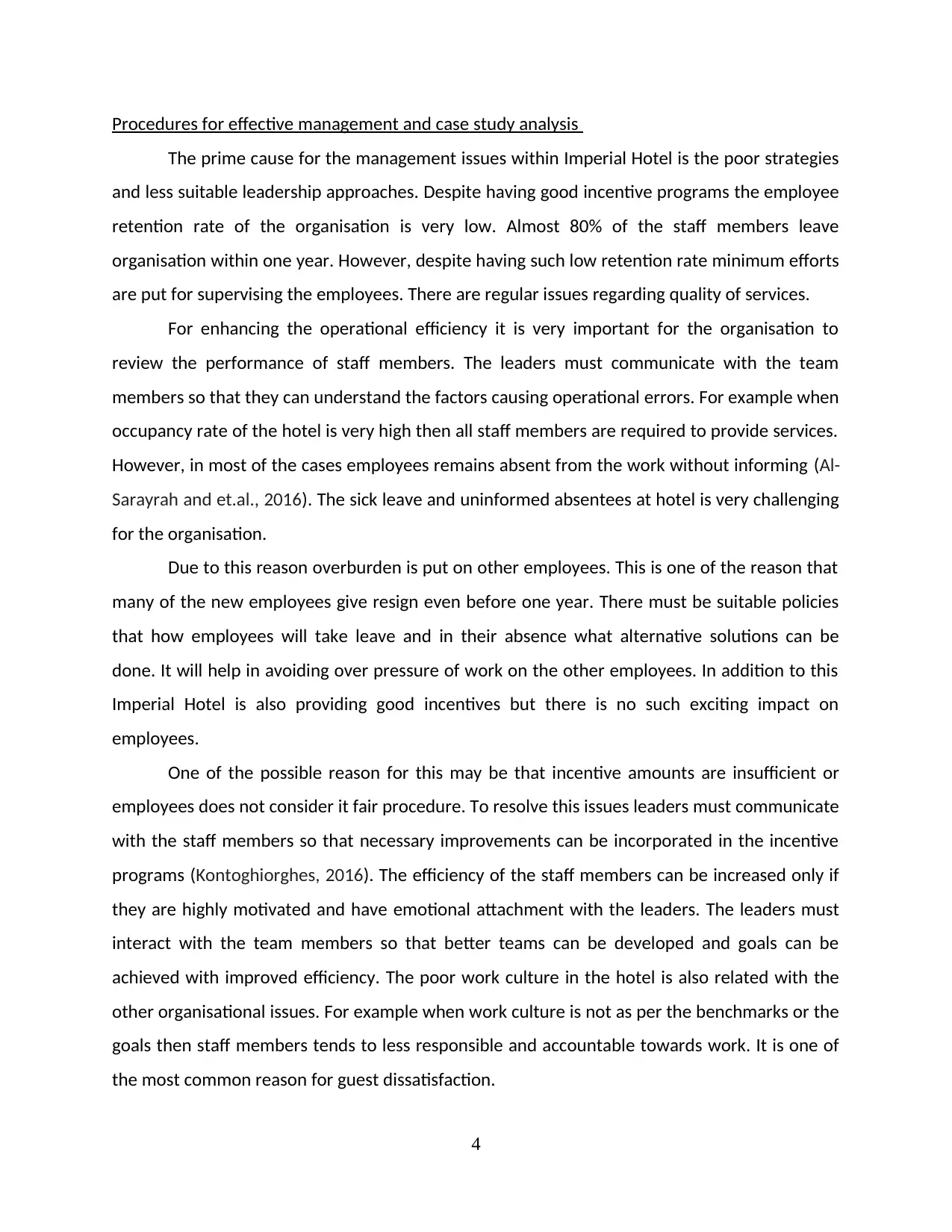
Procedures for effective management and case study analysis
The prime cause for the management issues within Imperial Hotel is the poor strategies
and less suitable leadership approaches. Despite having good incentive programs the employee
retention rate of the organisation is very low. Almost 80% of the staff members leave
organisation within one year. However, despite having such low retention rate minimum efforts
are put for supervising the employees. There are regular issues regarding quality of services.
For enhancing the operational efficiency it is very important for the organisation to
review the performance of staff members. The leaders must communicate with the team
members so that they can understand the factors causing operational errors. For example when
occupancy rate of the hotel is very high then all staff members are required to provide services.
However, in most of the cases employees remains absent from the work without informing (Al-
Sarayrah and et.al., 2016). The sick leave and uninformed absentees at hotel is very challenging
for the organisation.
Due to this reason overburden is put on other employees. This is one of the reason that
many of the new employees give resign even before one year. There must be suitable policies
that how employees will take leave and in their absence what alternative solutions can be
done. It will help in avoiding over pressure of work on the other employees. In addition to this
Imperial Hotel is also providing good incentives but there is no such exciting impact on
employees.
One of the possible reason for this may be that incentive amounts are insufficient or
employees does not consider it fair procedure. To resolve this issues leaders must communicate
with the staff members so that necessary improvements can be incorporated in the incentive
programs (Kontoghiorghes, 2016). The efficiency of the staff members can be increased only if
they are highly motivated and have emotional attachment with the leaders. The leaders must
interact with the team members so that better teams can be developed and goals can be
achieved with improved efficiency. The poor work culture in the hotel is also related with the
other organisational issues. For example when work culture is not as per the benchmarks or the
goals then staff members tends to less responsible and accountable towards work. It is one of
the most common reason for guest dissatisfaction.
4
The prime cause for the management issues within Imperial Hotel is the poor strategies
and less suitable leadership approaches. Despite having good incentive programs the employee
retention rate of the organisation is very low. Almost 80% of the staff members leave
organisation within one year. However, despite having such low retention rate minimum efforts
are put for supervising the employees. There are regular issues regarding quality of services.
For enhancing the operational efficiency it is very important for the organisation to
review the performance of staff members. The leaders must communicate with the team
members so that they can understand the factors causing operational errors. For example when
occupancy rate of the hotel is very high then all staff members are required to provide services.
However, in most of the cases employees remains absent from the work without informing (Al-
Sarayrah and et.al., 2016). The sick leave and uninformed absentees at hotel is very challenging
for the organisation.
Due to this reason overburden is put on other employees. This is one of the reason that
many of the new employees give resign even before one year. There must be suitable policies
that how employees will take leave and in their absence what alternative solutions can be
done. It will help in avoiding over pressure of work on the other employees. In addition to this
Imperial Hotel is also providing good incentives but there is no such exciting impact on
employees.
One of the possible reason for this may be that incentive amounts are insufficient or
employees does not consider it fair procedure. To resolve this issues leaders must communicate
with the staff members so that necessary improvements can be incorporated in the incentive
programs (Kontoghiorghes, 2016). The efficiency of the staff members can be increased only if
they are highly motivated and have emotional attachment with the leaders. The leaders must
interact with the team members so that better teams can be developed and goals can be
achieved with improved efficiency. The poor work culture in the hotel is also related with the
other organisational issues. For example when work culture is not as per the benchmarks or the
goals then staff members tends to less responsible and accountable towards work. It is one of
the most common reason for guest dissatisfaction.
4
⊘ This is a preview!⊘
Do you want full access?
Subscribe today to unlock all pages.

Trusted by 1+ million students worldwide
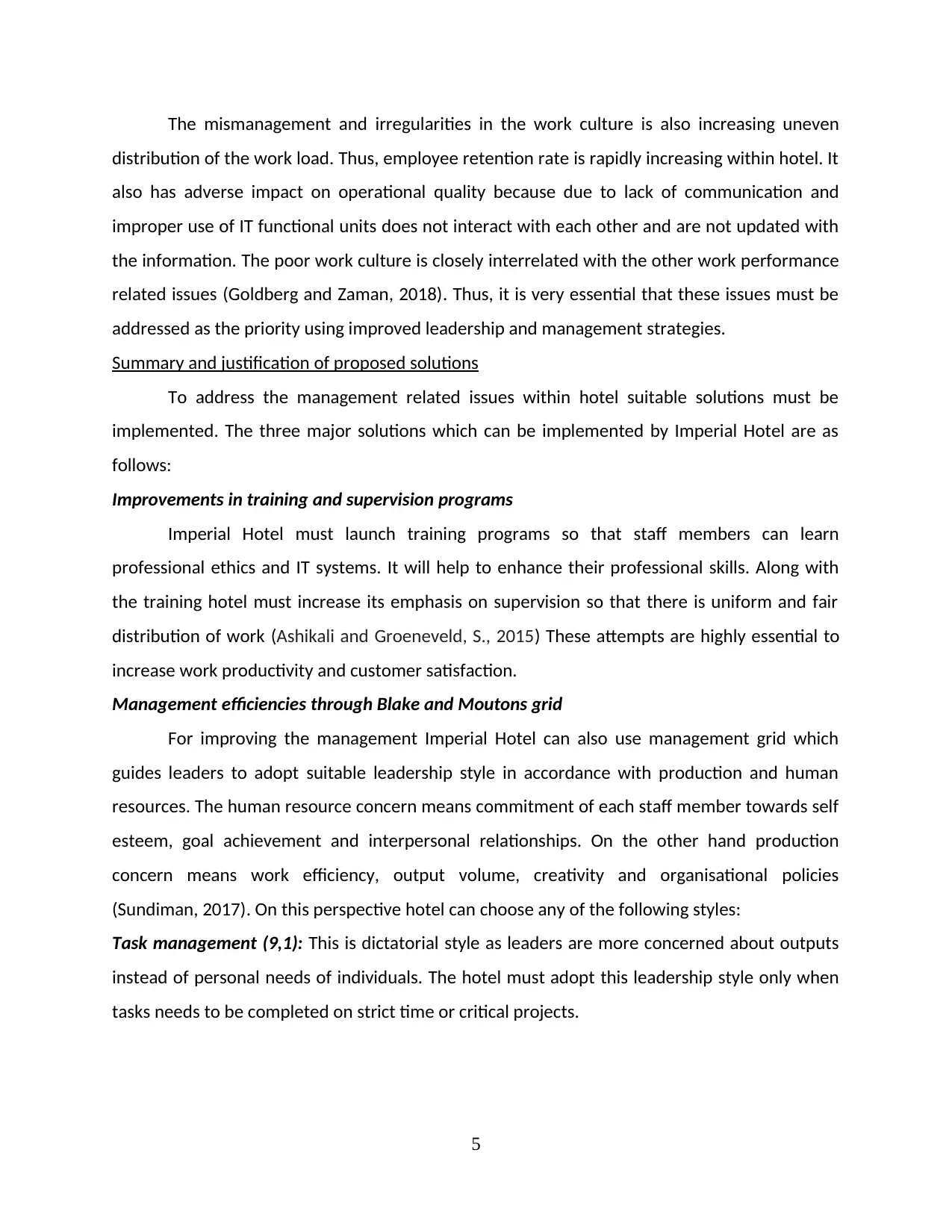
The mismanagement and irregularities in the work culture is also increasing uneven
distribution of the work load. Thus, employee retention rate is rapidly increasing within hotel. It
also has adverse impact on operational quality because due to lack of communication and
improper use of IT functional units does not interact with each other and are not updated with
the information. The poor work culture is closely interrelated with the other work performance
related issues (Goldberg and Zaman, 2018). Thus, it is very essential that these issues must be
addressed as the priority using improved leadership and management strategies.
Summary and justification of proposed solutions
To address the management related issues within hotel suitable solutions must be
implemented. The three major solutions which can be implemented by Imperial Hotel are as
follows:
Improvements in training and supervision programs
Imperial Hotel must launch training programs so that staff members can learn
professional ethics and IT systems. It will help to enhance their professional skills. Along with
the training hotel must increase its emphasis on supervision so that there is uniform and fair
distribution of work (Ashikali and Groeneveld, S., 2015) These attempts are highly essential to
increase work productivity and customer satisfaction.
Management efficiencies through Blake and Moutons grid
For improving the management Imperial Hotel can also use management grid which
guides leaders to adopt suitable leadership style in accordance with production and human
resources. The human resource concern means commitment of each staff member towards self
esteem, goal achievement and interpersonal relationships. On the other hand production
concern means work efficiency, output volume, creativity and organisational policies
(Sundiman, 2017). On this perspective hotel can choose any of the following styles:
Task management (9,1): This is dictatorial style as leaders are more concerned about outputs
instead of personal needs of individuals. The hotel must adopt this leadership style only when
tasks needs to be completed on strict time or critical projects.
5
distribution of the work load. Thus, employee retention rate is rapidly increasing within hotel. It
also has adverse impact on operational quality because due to lack of communication and
improper use of IT functional units does not interact with each other and are not updated with
the information. The poor work culture is closely interrelated with the other work performance
related issues (Goldberg and Zaman, 2018). Thus, it is very essential that these issues must be
addressed as the priority using improved leadership and management strategies.
Summary and justification of proposed solutions
To address the management related issues within hotel suitable solutions must be
implemented. The three major solutions which can be implemented by Imperial Hotel are as
follows:
Improvements in training and supervision programs
Imperial Hotel must launch training programs so that staff members can learn
professional ethics and IT systems. It will help to enhance their professional skills. Along with
the training hotel must increase its emphasis on supervision so that there is uniform and fair
distribution of work (Ashikali and Groeneveld, S., 2015) These attempts are highly essential to
increase work productivity and customer satisfaction.
Management efficiencies through Blake and Moutons grid
For improving the management Imperial Hotel can also use management grid which
guides leaders to adopt suitable leadership style in accordance with production and human
resources. The human resource concern means commitment of each staff member towards self
esteem, goal achievement and interpersonal relationships. On the other hand production
concern means work efficiency, output volume, creativity and organisational policies
(Sundiman, 2017). On this perspective hotel can choose any of the following styles:
Task management (9,1): This is dictatorial style as leaders are more concerned about outputs
instead of personal needs of individuals. The hotel must adopt this leadership style only when
tasks needs to be completed on strict time or critical projects.
5
Paraphrase This Document
Need a fresh take? Get an instant paraphrase of this document with our AI Paraphraser
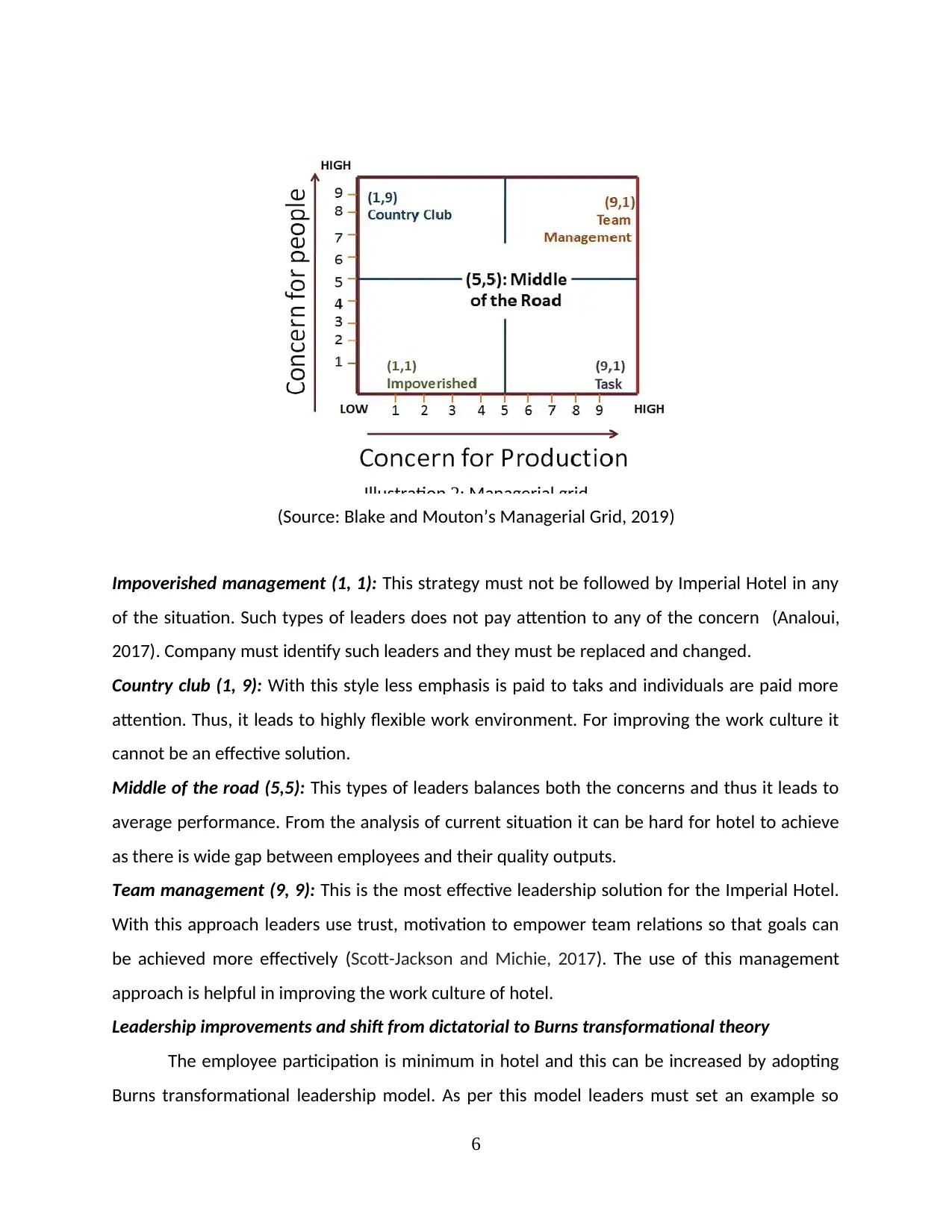
(Source: Blake and Mouton’s Managerial Grid, 2019)
Impoverished management (1, 1): This strategy must not be followed by Imperial Hotel in any
of the situation. Such types of leaders does not pay attention to any of the concern (Analoui,
2017). Company must identify such leaders and they must be replaced and changed.
Country club (1, 9): With this style less emphasis is paid to taks and individuals are paid more
attention. Thus, it leads to highly flexible work environment. For improving the work culture it
cannot be an effective solution.
Middle of the road (5,5): This types of leaders balances both the concerns and thus it leads to
average performance. From the analysis of current situation it can be hard for hotel to achieve
as there is wide gap between employees and their quality outputs.
Team management (9, 9): This is the most effective leadership solution for the Imperial Hotel.
With this approach leaders use trust, motivation to empower team relations so that goals can
be achieved more effectively (Scott-Jackson and Michie, 2017). The use of this management
approach is helpful in improving the work culture of hotel.
Leadership improvements and shift from dictatorial to Burns transformational theory
The employee participation is minimum in hotel and this can be increased by adopting
Burns transformational leadership model. As per this model leaders must set an example so
6
Illustration 2: Managerial grid
Impoverished management (1, 1): This strategy must not be followed by Imperial Hotel in any
of the situation. Such types of leaders does not pay attention to any of the concern (Analoui,
2017). Company must identify such leaders and they must be replaced and changed.
Country club (1, 9): With this style less emphasis is paid to taks and individuals are paid more
attention. Thus, it leads to highly flexible work environment. For improving the work culture it
cannot be an effective solution.
Middle of the road (5,5): This types of leaders balances both the concerns and thus it leads to
average performance. From the analysis of current situation it can be hard for hotel to achieve
as there is wide gap between employees and their quality outputs.
Team management (9, 9): This is the most effective leadership solution for the Imperial Hotel.
With this approach leaders use trust, motivation to empower team relations so that goals can
be achieved more effectively (Scott-Jackson and Michie, 2017). The use of this management
approach is helpful in improving the work culture of hotel.
Leadership improvements and shift from dictatorial to Burns transformational theory
The employee participation is minimum in hotel and this can be increased by adopting
Burns transformational leadership model. As per this model leaders must set an example so
6
Illustration 2: Managerial grid
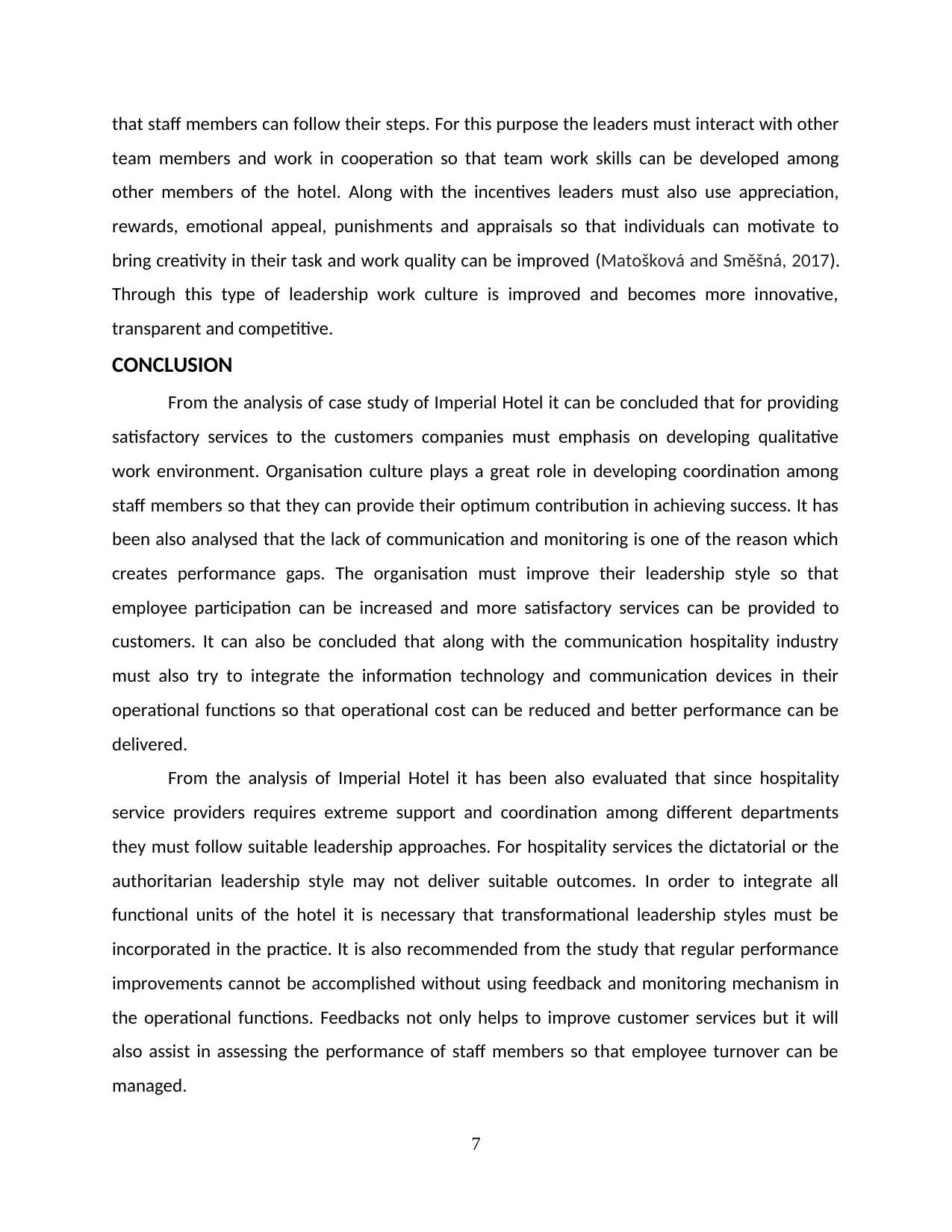
that staff members can follow their steps. For this purpose the leaders must interact with other
team members and work in cooperation so that team work skills can be developed among
other members of the hotel. Along with the incentives leaders must also use appreciation,
rewards, emotional appeal, punishments and appraisals so that individuals can motivate to
bring creativity in their task and work quality can be improved (Matošková and Směšná, 2017).
Through this type of leadership work culture is improved and becomes more innovative,
transparent and competitive.
CONCLUSION
From the analysis of case study of Imperial Hotel it can be concluded that for providing
satisfactory services to the customers companies must emphasis on developing qualitative
work environment. Organisation culture plays a great role in developing coordination among
staff members so that they can provide their optimum contribution in achieving success. It has
been also analysed that the lack of communication and monitoring is one of the reason which
creates performance gaps. The organisation must improve their leadership style so that
employee participation can be increased and more satisfactory services can be provided to
customers. It can also be concluded that along with the communication hospitality industry
must also try to integrate the information technology and communication devices in their
operational functions so that operational cost can be reduced and better performance can be
delivered.
From the analysis of Imperial Hotel it has been also evaluated that since hospitality
service providers requires extreme support and coordination among different departments
they must follow suitable leadership approaches. For hospitality services the dictatorial or the
authoritarian leadership style may not deliver suitable outcomes. In order to integrate all
functional units of the hotel it is necessary that transformational leadership styles must be
incorporated in the practice. It is also recommended from the study that regular performance
improvements cannot be accomplished without using feedback and monitoring mechanism in
the operational functions. Feedbacks not only helps to improve customer services but it will
also assist in assessing the performance of staff members so that employee turnover can be
managed.
7
team members and work in cooperation so that team work skills can be developed among
other members of the hotel. Along with the incentives leaders must also use appreciation,
rewards, emotional appeal, punishments and appraisals so that individuals can motivate to
bring creativity in their task and work quality can be improved (Matošková and Směšná, 2017).
Through this type of leadership work culture is improved and becomes more innovative,
transparent and competitive.
CONCLUSION
From the analysis of case study of Imperial Hotel it can be concluded that for providing
satisfactory services to the customers companies must emphasis on developing qualitative
work environment. Organisation culture plays a great role in developing coordination among
staff members so that they can provide their optimum contribution in achieving success. It has
been also analysed that the lack of communication and monitoring is one of the reason which
creates performance gaps. The organisation must improve their leadership style so that
employee participation can be increased and more satisfactory services can be provided to
customers. It can also be concluded that along with the communication hospitality industry
must also try to integrate the information technology and communication devices in their
operational functions so that operational cost can be reduced and better performance can be
delivered.
From the analysis of Imperial Hotel it has been also evaluated that since hospitality
service providers requires extreme support and coordination among different departments
they must follow suitable leadership approaches. For hospitality services the dictatorial or the
authoritarian leadership style may not deliver suitable outcomes. In order to integrate all
functional units of the hotel it is necessary that transformational leadership styles must be
incorporated in the practice. It is also recommended from the study that regular performance
improvements cannot be accomplished without using feedback and monitoring mechanism in
the operational functions. Feedbacks not only helps to improve customer services but it will
also assist in assessing the performance of staff members so that employee turnover can be
managed.
7
⊘ This is a preview!⊘
Do you want full access?
Subscribe today to unlock all pages.

Trusted by 1+ million students worldwide

8
Paraphrase This Document
Need a fresh take? Get an instant paraphrase of this document with our AI Paraphraser
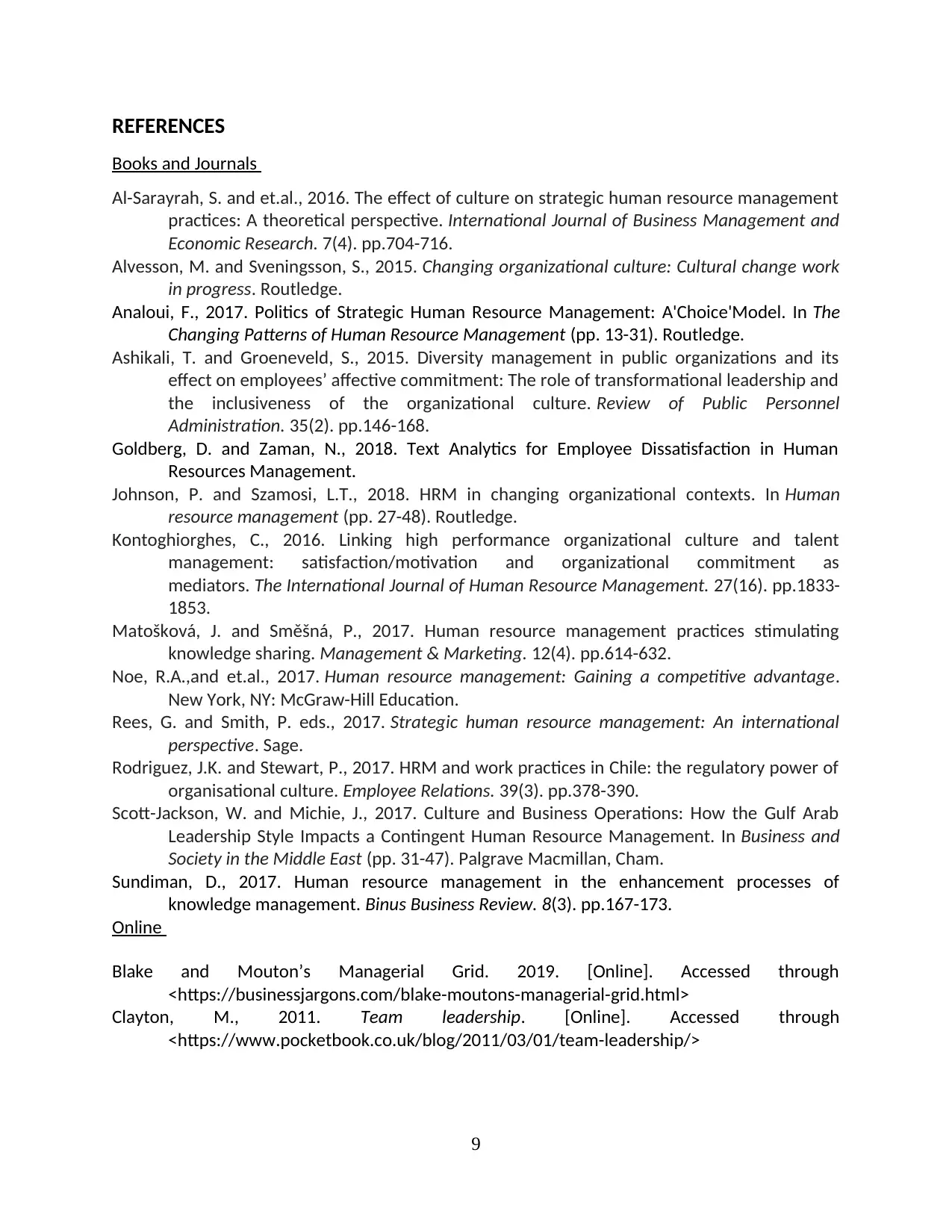
REFERENCES
Books and Journals
Al-Sarayrah, S. and et.al., 2016. The effect of culture on strategic human resource management
practices: A theoretical perspective. International Journal of Business Management and
Economic Research. 7(4). pp.704-716.
Alvesson, M. and Sveningsson, S., 2015. Changing organizational culture: Cultural change work
in progress. Routledge.
Analoui, F., 2017. Politics of Strategic Human Resource Management: A'Choice'Model. In The
Changing Patterns of Human Resource Management (pp. 13-31). Routledge.
Ashikali, T. and Groeneveld, S., 2015. Diversity management in public organizations and its
effect on employees’ affective commitment: The role of transformational leadership and
the inclusiveness of the organizational culture. Review of Public Personnel
Administration. 35(2). pp.146-168.
Goldberg, D. and Zaman, N., 2018. Text Analytics for Employee Dissatisfaction in Human
Resources Management.
Johnson, P. and Szamosi, L.T., 2018. HRM in changing organizational contexts. In Human
resource management (pp. 27-48). Routledge.
Kontoghiorghes, C., 2016. Linking high performance organizational culture and talent
management: satisfaction/motivation and organizational commitment as
mediators. The International Journal of Human Resource Management. 27(16). pp.1833-
1853.
Matošková, J. and Směšná, P., 2017. Human resource management practices stimulating
knowledge sharing. Management & Marketing. 12(4). pp.614-632.
Noe, R.A.,and et.al., 2017. Human resource management: Gaining a competitive advantage.
New York, NY: McGraw-Hill Education.
Rees, G. and Smith, P. eds., 2017. Strategic human resource management: An international
perspective. Sage.
Rodriguez, J.K. and Stewart, P., 2017. HRM and work practices in Chile: the regulatory power of
organisational culture. Employee Relations. 39(3). pp.378-390.
Scott-Jackson, W. and Michie, J., 2017. Culture and Business Operations: How the Gulf Arab
Leadership Style Impacts a Contingent Human Resource Management. In Business and
Society in the Middle East (pp. 31-47). Palgrave Macmillan, Cham.
Sundiman, D., 2017. Human resource management in the enhancement processes of
knowledge management. Binus Business Review. 8(3). pp.167-173.
Online
Blake and Mouton’s Managerial Grid. 2019. [Online]. Accessed through
<https://businessjargons.com/blake-moutons-managerial-grid.html>
Clayton, M., 2011. Team leadership. [Online]. Accessed through
<https://www.pocketbook.co.uk/blog/2011/03/01/team-leadership/>
9
Books and Journals
Al-Sarayrah, S. and et.al., 2016. The effect of culture on strategic human resource management
practices: A theoretical perspective. International Journal of Business Management and
Economic Research. 7(4). pp.704-716.
Alvesson, M. and Sveningsson, S., 2015. Changing organizational culture: Cultural change work
in progress. Routledge.
Analoui, F., 2017. Politics of Strategic Human Resource Management: A'Choice'Model. In The
Changing Patterns of Human Resource Management (pp. 13-31). Routledge.
Ashikali, T. and Groeneveld, S., 2015. Diversity management in public organizations and its
effect on employees’ affective commitment: The role of transformational leadership and
the inclusiveness of the organizational culture. Review of Public Personnel
Administration. 35(2). pp.146-168.
Goldberg, D. and Zaman, N., 2018. Text Analytics for Employee Dissatisfaction in Human
Resources Management.
Johnson, P. and Szamosi, L.T., 2018. HRM in changing organizational contexts. In Human
resource management (pp. 27-48). Routledge.
Kontoghiorghes, C., 2016. Linking high performance organizational culture and talent
management: satisfaction/motivation and organizational commitment as
mediators. The International Journal of Human Resource Management. 27(16). pp.1833-
1853.
Matošková, J. and Směšná, P., 2017. Human resource management practices stimulating
knowledge sharing. Management & Marketing. 12(4). pp.614-632.
Noe, R.A.,and et.al., 2017. Human resource management: Gaining a competitive advantage.
New York, NY: McGraw-Hill Education.
Rees, G. and Smith, P. eds., 2017. Strategic human resource management: An international
perspective. Sage.
Rodriguez, J.K. and Stewart, P., 2017. HRM and work practices in Chile: the regulatory power of
organisational culture. Employee Relations. 39(3). pp.378-390.
Scott-Jackson, W. and Michie, J., 2017. Culture and Business Operations: How the Gulf Arab
Leadership Style Impacts a Contingent Human Resource Management. In Business and
Society in the Middle East (pp. 31-47). Palgrave Macmillan, Cham.
Sundiman, D., 2017. Human resource management in the enhancement processes of
knowledge management. Binus Business Review. 8(3). pp.167-173.
Online
Blake and Mouton’s Managerial Grid. 2019. [Online]. Accessed through
<https://businessjargons.com/blake-moutons-managerial-grid.html>
Clayton, M., 2011. Team leadership. [Online]. Accessed through
<https://www.pocketbook.co.uk/blog/2011/03/01/team-leadership/>
9

10
⊘ This is a preview!⊘
Do you want full access?
Subscribe today to unlock all pages.

Trusted by 1+ million students worldwide
1 out of 16
Related Documents
Your All-in-One AI-Powered Toolkit for Academic Success.
+13062052269
info@desklib.com
Available 24*7 on WhatsApp / Email
![[object Object]](/_next/static/media/star-bottom.7253800d.svg)
Unlock your academic potential
Copyright © 2020–2025 A2Z Services. All Rights Reserved. Developed and managed by ZUCOL.




